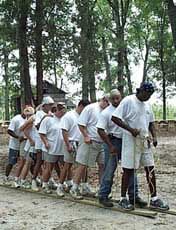

There are several ways in which the team leader can contribute to creating a positive climate within the team. One of the most powerful forces is to put forward, in cooperation with team members, an exciting vision/purpose of what the team is to achieve. Once the vision is developed, it needs to be kept in front of the team members as a reminder of what they wish to accomplish.
The team leader where possible should help select or influence the composition of team members. Selection should be based on willingness of people to work in a team setting and the resources, both people skills and technical components, they are able to bring to the team.

The team leader should be the liaison between the team and upper management. The team leader needs to know and work with upper management to obtain a full commitment from them in support of the team's program.
However, when this happens, team members must realize that they have a major responsibility to make maximum use of the resources and support provided.
The team leader can encourage team member growth, and should be willing to take some risk by having members whose resources are relevant to the immediate task provide the leadership.
The team leader should be fair, supportive, and recognized by team members as one who can make final judgments, work with upper management, and give direction to the team as needed.
As team members build commitment, trust, and support for one another, it will allow them to develop and accomplish desired results. This commitment, trust, and self-determination by each team member is critical in achieving a sustained high level of performance. Team members will learn to appreciate and enjoy one another for who they are and will help keep one another on track. The team will have developed its working methods so that they become an informal set of guidelines.
Each of us can evaluate how well team members are working together, using the following statements as a guide:
- Team goals are developed through a group process of team interaction and agreement in which each team member is willing to work toward achieving these goals.
- Participation is actively shown by all team members and roles are shared to facilitate the accomplishment of tasks and feelings of group togetherness.
- Feedback is asked for by members and freely given as a way of evaluating the team's performance and clarifying both feelings and interests of the team members. When feedback is given it is done with a desire to help the other person.
- Team decision making involves a process that encourages active participation by all members.
- Leadership is distributed and shared among team members and individuals willingly contribute their resources as needed.
- Problem solving, discussing team issues, and critiquing team effectiveness are encouraged by all team members.
- Conflict is not suppressed. Team members are allowed to express negative feelings and confrontation within the team which is managed and dealt with by team members. Dealing with and managing conflict is seen as a way to improve team performance.
- Team member resources, talents, skills, knowledge, and experiences are fully identified, recognized, and used whenever appropriate.
- Risk taking and creativity are encouraged. When mistakes are made, they are treated as a source of learning rather than reasons for punishment.

VI "Parasportas" Ozeskienes 4-2, Kaunas 3000, Lthuania, ph: +370 (698) 36598,+370 (686) 33966, fax:+370 (37) 407991 sportas@rodali.lt